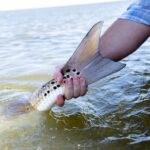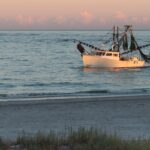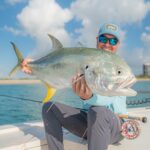New Alabama Redfish Regs: Conservation Momentum Grows
Photo Credit: Graham Tayloe Big Win for Redfish in Alabama Huge news from the Marine
Community research aims to answer a question vital to fisheries management in Louisiana:
How much are redfish worth to the state?
Title Photo Credit: Hayden Dobbins, “Hooked On: Redfish” Film.
ASGA Louisiana Red Drum Angler Expenditure Survey: Summary of Results
Introduction
To quantify angler expenditures associated with Louisiana’s for-hire light-tackle recreational fishery for red drum (Sciaenops ocellatus), the American Saltwater Guides Association (ASGA) recently collaborated with members of Louisiana’s guide community to develop a survey for distribution to clients. The motivating factor for this study was ongoing concern about the status of the state’s red drum resource, which has led to discussions concerning future management strategies for this iconic species. While the fishery attracts and sustains a significant following whose primary motivation is light-tackle catch-and-release fishing, there have to date been no efforts to estimate the relative expenditures of this specialized group compared to Louisiana’s broader recreational community. Instead, the only available expenditure estimates are for Louisiana’s recreational fishery as a whole (Lovell et al. 2020).
Methods
Survey Development
In partnership with guides in Southeast Louisiana’s light-tackle red drum fishery, ASGA designed a survey that coupled questions specific to the fishery with expenditure and demographic questions. The survey was intended only for anglers who had fished with a Louisiana saltwater guide or charter captain in the 12 months prior to taking the survey. The full survey, which was developed and distributed using the online survey platform SurveyMonkey, can be viewed here.
Fishery-specific questions, which focused on respondents’ most recent saltwater fishing trip with a Louisiana guide, included asking whether red drum were a target species, the type of fishing gear used (e.g., fly fishing, spin fishing with lures, spin fishing with bait), and the primary factors motivating anglers to take the trip (e.g., to catch a red drum, to take a red drum home to eat, to catch a trophy red drum).
Questions on angler expenditures and expenditure categories closely paralleled those asked in the 2016-2017 NOAA Fisheries’ Angler Expenditures Survey (Lovell et al. 2020), which estimated angler expenditures both at the national level and by state, including for Louisiana (using a stratified sample of state fishing licenses). Doing so facilitated the ability to compare expenditure estimates between the two surveys. In some instances, wording was changed slightly to reflect the target respondent pool—for example, Lovell et al.’s survey included a question on expenditures for “Galley tab & souvenirs bought on charter/party boat,” which was adjusted in the current survey to “Merchandise or other mementos bought on charter/guide trip (e.g., t-shirt, hat).” Respondents were asked to provide information on their most recent saltwater fishing trip in Louisiana, including whether they spent any nights away from home, the number of days spent fishing, and itemization of personal trip-related expenses (including the percentage of such expenses spent in Louisiana) such as food and drink, fuel, guide fees, and lodging. To avoid confusion associated with whether to leave an entry blank or type “0” if no expenditure for a given category was made, respondents were instructed to write “0” if there was no expenditure and were required to fill out all expenditure categories.
Lastly, the survey asked key demographic questions, including whether the respondent was a full/part-time resident of Louisiana and their annual income.
Survey Distribution
Survey distribution relied heavily on outreach from red drum guides to their clients and employed a snowball sampling approach. Due to the lack of a defined survey frame for light-tackle red drum anglers, ASGA instead provided guides with materials describing the survey’s purpose and instructions for how to access it. In total, over 40 guides in southeast Louisiana assisted with survey distribution, which included a) sending an email to their client lists describing the survey and providing a link; and b) pasting stickers on their boat that included a QR code linking to the survey. Anglers were encouraged to forward the survey to others, and some light-tackle/fly-fishing media outlets such as FlyLords posted articles on their websites as well. Responses were anonymous, and to prevent multiple responses from a single angler a restriction was put in place allowing the survey to be completed only one time per device.
The survey was released in November 2022 and remained open for response collection until July 2023.
Response Analysis
To enable comparison with previous recreational expenditure estimates for Louisiana, analytical methods closely followed those of Lovell et al. 2020. Survey responses were used to estimate average expenditures per angler-trip, defined as one day of fishing for one angler. Expenditures were estimated for Louisiana residents and non-residents combined, following Lovell et al. 2020. Expenditures per angler-trip were estimated by dividing total reported expenditures by the number of days spent fishing (for direct fishing-related expenditures such as guided trip fees) or by the number of nights spent away from home (for non-direct expenditures such as fuel and lodging).
Responses for which expenditure estimates appeared unrealistically high (e.g., $50,100 in merchandise for two anglers) were not included in the analyses. If a respondent indicated an expenditure for a given category but left blank the percentage of the expenditure made in Louisiana (or submitted a percentage of greater than 100%), the percentage was assumed to be 100% for Louisiana residents and part-time residents. For non-residents, the percentage was assumed to be the average percentage spent on that item in Louisiana for other non-residents.
Mean expenditures per angler-trip were estimated for each category included in the survey, along with the standard error. Due to the non-normal distribution of the expenditure data across respondents and the unavailability of individual angler-trip expenditure information from the Lovell et al. 2020 study, statistical comparisons between the two studies could not be conducted. Instead, comparisons between the two studies were conducted qualitatively through examining the mean and standard error of expenditures per angler trip across the different expenditure categories.
Results
Response Rate and Respondent Characteristics
A total of 170 anglers submitted answers to the survey,[1] and the majority of responses (92%) were received between November 2022 and February 2023. The vast majority of respondents (94.2%) who shared Louisiana residency status were nonresidents (Table 1).
Table 1. Respondents by Louisiana residency status.
|
Louisiana Residency Status |
Number of Respondents |
Percent of Respondents |
|
Full-time Resident |
6 |
3.9% |
|
Part-time/Seasonal Resident |
3 |
1.9% |
|
Non-resident |
146 |
94.2% |
|
Total |
155 |
Of the 145 respondents who provided annual income information, nearly three quarters had an annual income of over $100,000, with over 57% reporting an annual income of over $150,000 (Table 2).
Table 2. Income of respondents.
|
Annual Income |
Number of Respondents |
Percent of Respondents |
|
Less than $30,000 |
2 |
1.4% |
|
$30,000-$49,999 |
4 |
2.76% |
|
$50,000-$74,999 |
13 |
9.0% |
|
$75,000-$99,999 |
19 |
13.1% |
|
$100,000-$150,000 |
24 |
16.6% |
|
Over $150,000 |
83 |
57.2% |
|
Total |
145 |
Fishing Behavior and Attitudes
Respondents indicated having fished with a Louisiana saltwater guide for between 1 and 40 days in the previous 12 months, with an average of 4.9 days. Over 90% of respondents fished for less than 10 days with a Louisiana fishing guide in the previous 12 months (Figure 1).

Figure 1. Responses to the question: During the last 12 months that includes your most recent guided trip, how many days have you fished with a Louisiana saltwater guide or charter captain? (N = 170)
Of the southeastern Louisiana ports included in the survey, the majority of respondents (110, or 64%) indicated that their most recent trip with a Louisiana guide had originated from Hopedale. The second most-common ports of origin were Cocodrie (24 respondents, or 14%) and Venice (12 respondents, or 7%) (Figure 2).

Figure 2. Location of origin for respondents’ most recent saltwater fishing trip with a Louisiana guide or charter captain.
Most respondents primarily fished either only with fly fishing gear (102, or 60%) or with a combination of fly fishing and spin fishing gear (with lures and natural bait) (64, or 38%) (Figure 3).

Figure 3. Gear type used on most recent saltwater fishing trip with a Louisiana guide or charter captain.
Angler Attitudes
To provide insight into the motivations prompting respondents to go on their last guided trip in Louisiana, they were asked to indicate the importance of relative factors in their decision to take the trip (Figure 4). Eighty-five percent of respondents ranked catching a red drum as an extremely or very important factor, followed by spending time on the water (83% of respondents) and spending time with friends and family (67%). Conversely, nearly all respondents (96%) ranked harvesting a red drum as not at all important, underscoring the nonconsumptive orientation of the respondent pool.

Figure 4. The importance of various factors in impacting anglers’ decisions to take their most recent trip with a Louisiana saltwater fishing guide. Percentages on the left side of the plot denote less importance, percentages in the middle denote neutral importance, and percentages on the right denote more importance.
Meanwhile, when asked to rank the most important factor impacting their decision to take their most recent trip, the most commonly selected answer was to catch a trophy red drum, selected by nearly a third of respondents (32%) (Figure 5).

Figure 5. The most important factor impacting anglers’ decisions to take their most recent trip with a Louisiana saltwater fishing guide.
Expenditures
96% of respondents (167) indicated that they personally incurred expenses associated with their most recent guided saltwater fishing trip in Louisiana, with 88% (149) providing expenditure information. Average expenditures per angler-trip in both the current study and in Lovell et al. 2020 are illustrated in both Table 3 and Figure 6. As mentioned previously, due to data limitations statistical comparisons were not possible between the two datasets. Qualitatively, expenditures per-angler trip between the two studies were similar for auto/truck/RV fuel, guide fees/merchandise, and fish processing. Respondents to the Lovell et al. 2020 survey spent more on bait and ice, while respondents in this study spent more on food (from both grocery stores and restaurants), auto/truck/RV rentals, lodging, and airfare, among others. Overall mean expenditures per angler-trip in the current study were $1,075.32, compared to $737.19 estimated by Lovell et al. 2020 (after adjusting for inflation), or approximately 46% higher.
Table 3. Mean expenditures per angler-trip, along with standard errors, for Louisiana recreational anglers across key categories for both the current study and a 2016-2017 expenditure survey conducted by NOAA Fisheries (Lovell et al. 2020). Lovell et al. 2020 estimates were adjusted to January 2023 dollars to account for inflation. “Crew tips” were not included as an expenditure category in the current study.
|
Current Study |
Lovell et al. 2020 (Jan 2023 $) |
|||||
|
Expenditure Category |
N |
Mean |
SE |
N |
Mean |
SE |
|
Food and drink from grocery or convenience stores |
149 |
$135.75 |
$27.89 |
110 |
$51.96 |
$6.71 |
|
Food and drink from restaurants and bars |
149 |
$102.04 |
$9.75 |
112 |
$51.34 |
$7.31 |
|
Parking, site access fees, and tolls |
149 |
$17.11 |
$6.02 |
110 |
$0.49 |
$0.21 |
|
Auto, truck, or RV fuel |
149 |
$26.82 |
$3.96 |
112 |
$29.63 |
$3.49 |
|
Auto, truck, or RV rental |
149 |
$65.90 |
$8.87 |
109 |
$1.76 |
$1.15 |
|
Baita |
147 |
$0.63 |
$0.28 |
108 |
$7.50 |
$2.16 |
|
Icea |
147 |
$1.49 |
$0.25 |
112 |
$5.38 |
$1.03 |
|
Guide/charter trips, fish filleting fees, and trip-related merchandisea,b |
147 |
$408.70 |
$31.17 |
111 |
$451.42 |
$58.58 |
|
Crew tips |
— |
— |
— |
112 |
$48.70 |
$6.94 |
|
Lodging (hotels, motels, campgrounds, etc.) |
149 |
$229.20 |
$36.62 |
110 |
$75.31 |
$14.83 |
|
Public/ride-share transportation |
149 |
$10.05 |
$2.36 |
111 |
$0.00 |
$0.00 |
|
Airfare |
149 |
$55.63 |
$13.45 |
109 |
$10.24 |
$5.94 |
|
Gifts or souvenirs |
149 |
$19.43 |
$12.12 |
106 |
$2.56 |
$1.02 |
|
Processing, freezing, or shipping fee paid to fish processing company |
149 |
$0.84 |
$0.84 |
110 |
$0.90 |
$0.87 |
|
Total |
— |
$1,075.32 |
— |
— |
$737.19 |
— |
a Two respondents did not indicate how many days they spent fishing, reducing the sample size for direct trip-related expenditures from 149 to 147.
b Following Lovell et al., guided/charter trip fees and trip-related merchandise/mementos were included as separate expenditure categories in the survey but combined into one value.

Figure 6. Graphical representation of Table 3: Mean expenditures per angler-trip, along with standard errors (black vertical bars), for Louisiana recreational anglers across key categories for both the current study (blue) and a 2016-2017 expenditure survey conducted by NOAA Fisheries (Lovell et al. 2020) (gray). Lovell et al. 2020 estimates were adjusted to January 2023 dollars to account for inflation. “Crew tips” were not included as an expenditure category in the current study.
Conclusions
This survey successfully targeted a subset of specialized anglers who participate in Louisiana’s for-hire light-tackle red drum fishery in southeastern Louisiana. Respondents were primarily out-of-state anglers, who were almost exclusively motivated by non-consumptive elements of fishing for red drum, including catching (but not harvesting) red drum, spending time on the water/with friends and family, and catching trophy red drum. In other words, the economic activity associated with these anglers is not directly tied to the ability to harvest fish. In addition, the survey revealed that a substantial number of anglers—about a third of respondents—are primarily drawn to fish in Louisiana by the opportunity to encounter trophy-sized red drum.
A qualitative comparison of average expenditures per angler-trip with results of a previous more general study of Louisiana for-hire fishery anglers (Lovell et al. 2020) suggested that participants in Louisiana’s light-tackle red drum fishery spend more on food, lodging, car rentals, and gifts, among other categories. This may largely reflect the fact that, while resident and non-resident responses were combined for analysis in both surveys, respondents to the current survey were predominantly non-resident—a testament to the broad appeal of Louisiana’s light-tackle red drum fishery.
Given the lack of data on overall fishing effort associated with Louisiana’s light-tackle red drum fishery, the current study did not estimate total expenditures by fishery participants or the economic contributions of those participants. It does, however, provide evidence that anglers who participate in this fishery tend to spend more per trip than the average participant in Louisiana’s for-hire recreational fisheries.
References
Lovell, Sabrina, James Hilger, Emily Rollins, Noelle A. Olsen, and Scott Steinback. 2020. The
Economic Contribution of Marine Angler Expenditures on Fishing Trips in the United States, 2017. U.S. Dep. Commerce, NOAA Tech. Memo. NMFS-F/SPO-201, 80 p.
One respondent indicated having fished 100 days with a Louisiana saltwater guide in the previous 12 months but having incurred zero guide expenses on their most recent trip; as result, it was determined that this individual was either a) a private angler or b) a Louisiana saltwater fishing guide, and their responses were removed from subsequent analyses. In addition, all but one respondent indicated that red drum were either a primary target (166; 97.1%) or a secondary target (4; 2.3%) on their most recent trip; responses for that one individual were also removed from the analysis. ↑

Photo Credit: Graham Tayloe Big Win for Redfish in Alabama Huge news from the Marine

Feature Photo: Carter Abramson | Simms Fishing at the Fisheries Science Symposium We have more

Each year, hundreds of millions of fish are killed as collateral damage from large-scale, inshore

Feature Photo Credit: Scientific Anglers Team At the heart of the Jack Project is a
We rely on our members and donations to keep fighting for a sustainable tomorrow in marine conservation.
GIVE THE GIFT OF FISHERIES CONSERVATION THIS HOLIDAY SEASON. SHOP ASGA GOODS THAT FUND FISHERIES RESEARCH & ADVOCACY CAMPAIGNS
JOIN ASGA IN CALLING FOR CRITICAL MANAGEMENT ACTION AFTER YEARS OF SPAWN FAILURES & POOR MANAGEMENT.
By using this website, you agree to our use of cookies. We use cookies to provide you with a great experience and to help our website run effectively. To learn more, please review our privacy policy.
One Response